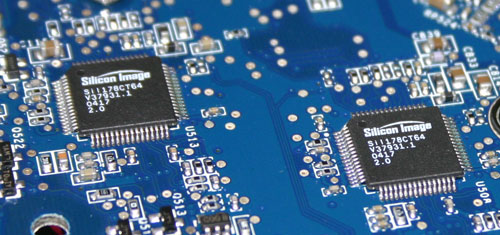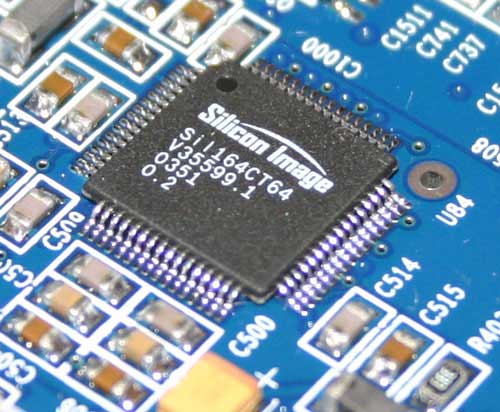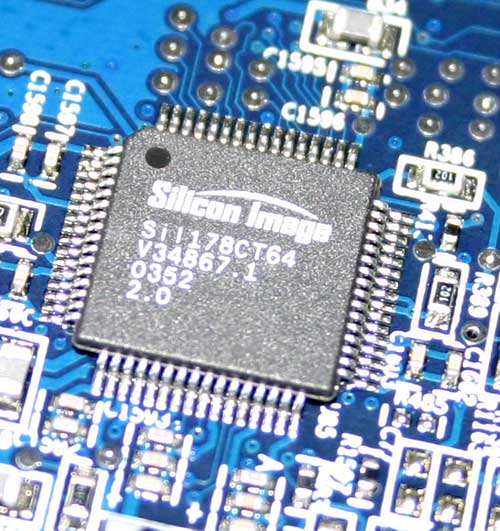ATI Radeon X800 XT Mac Edition: Competition in the Mac Market
by Anand Lal Shimpi on January 5, 2005 7:38 PM EST- Posted in
- Mac
Dual Dual Link
Before the launch of their 30” Cinema Display, Apple went to ATI and NVIDIA with the requirements of the new display to get an idea of what graphics cards would support it. Apple ended up launching the new displays (along with the new 2.5GHz Power Mac) with NVIDIA’s GeForce 6800 Ultra DDL, even though ATI was ready to go with the X800 XT Mac Edition. All of Apple’s new Cinema Displays are DVI only, so in order to understand the reason Apple chose NVIDIA’s GeForce 6800 Ultra DDL over ATI’s Radeon X800 XT Mac Edition you have to know a little bit about the DVI specification.
The DVI spec transmits data using the transition minimized differential signaling (TMDS) protocol. The DVI spec calls for each DVI output to have at least one TMDS “link” consisting of three data channels (RGB) and one control channel. The maximum speed at which a single 10-bit TMDS link may operate at is 165MHz, offering 1.65Gbps of bandwidth. In real world terms, this means a single 10-bit TMDS link can drive a display at up to 1920 x 1200 (the actual maximum resolution can vary depending on the panel). For most displays that’s not a problem, but Apple’s 30” Cinema Display has a native resolution of 2560 x 1600, which exceeds the bandwidth a single TMDS link can deliver. So what do you do? Remember that the DVI spec calls for at least one TMDS link, but each DVI port can support up to two TMDS links, doubling the maximum bandwidth and thus enabling support for Apple’s 30” display.
To support a single 30” Cinema Display, you simply need a card with one dual-link DVI port. To support a 30” Cinema Display and a second panel with a 1920 x 1200 (or lower) resolution you’d need one dual-link DVI port and one single-link DVI port. However to support two 30” Cinema Displays, you need a card with two dual-link DVI ports. And this is what separates the NVIDIA GeForce 6800 Ultra DDL from the X800 XT Mac Edition.
The GeForce 6800 Ultra DDL uses two external dual-link TMDS transmitters manufactured by Silicon Image – the 178CT64. The two transmitters are located on the back of the card and drive the two dual-link DVI outputs, enabling any possible display configuration with the NVIDIA card.

Two Dual-Link TMDS transmitters on the back of NVIDIA's 6800 Ultra DDL
The ATI Radeon 9800 Pro Mac Special Edition features a single external TMDS transmitter and one internal TMDS transmitter, both single-link. The external TMDS transmitter is also manufactured by Silicon Image, the 164CT64.

ATI's 9800 Pro Mac SE uses a single link TMDS transmitter
The new Radeon X800 XT Mac Edition still has the same internal single-link TMDS transmitter as the Radeon 9800 Pro Mac SE, but now features a 24-bit internal VDO port. The internal port can connect to two external TMDS links to provide a dual-link DVI output. ATI actually uses the same Silicon Image TMDS transmitter as NVIDIA, the 178CT64, and interfaces to it using their internal 24-bit VDO port. The internal TMDS is only single link so the X800 XT Mac Edition uses that to drive its ADC port, while the external dual-link TMDS drives the dual-link DVI port. ATI’s inability to drive two 30” Cinema Displays is what gave NVIDIA the design win with the 2.5GHz G5 system, but ATI insists that very few users will have two 30” displays and thus the flexibility of one ADC and one dual-link DVI connector is more than enough for the majority of the market.

The new X800 XT Mac Edition only features one external dual-link TMDS transmitter
So immediately off the bat, if you want to run two 30” Cinema Displays, then your only option continues to be the GeForce 6800 Ultra DDL. Otherwise, the X800 XT Mac Edition is still in the running.










35 Comments
View All Comments
gizzard - Saturday, January 8, 2005 - link
Hey, that's me! =)Quite simply, the reason the ATI card is faster is because it has better drivers, (The higher core clock speed helps also.) You can really see it in the lower resolution Quake3 scores when even the 9600 XT and 9800 Pro beat out the 6800. Driver inefficiencies can sometimes be exposed by looking at low resolution performance, which is why I always publish them.
It is difficult to see the large performance deltas in Anand's review because he didn't perform many tests with FSAA and AF enabled — that is where the X800 XT shines. Also, his conclusion of the RtCW scores was not entirely accurate: "The story is pretty simple here, on older games, the 9800 is already CPU bound thus making the 6800 Ultra and X800 XT not too interesting to look at." RtCW is a heavily CPU bound game. Given the same CPU, you won't see a large delta unless you compare a Rage 128 to an X800 XT — and his results show that. I'm just not sure how he arrived at that conclusion . =)
I'm hoping that Anand will speak up in the comments section to clear things up. I'd be very interested in what he has to say. And as everyone said, what Anand is doing is A Good Thing.™
gankaku - Saturday, January 8, 2005 - link
I was interested to read Anand's take on the new ATi X800 XT for several reasons, including:1) his earlier fair, well-written article on a month with a Mac
2) his status in the PC World as an honest broker, and his rigorous testing procedures
3) the fact that his opinion does carry some weight, and may help improve hardware offerings in the Mac world. We've got it pretty good right now, but articles that spread light (and not just heat) are always appreciated.
But, after all that, his results surprised me. That's because I read an earlier review of the new ATi card at Inside Mac Games, with the results indicating that the ATi card is a much better buy.
I'm not enough of a geek to understand why ATi scored better at IMG, but I'm sure that some lively debate on this list will release both heat and light in the subsequent discussions here.
http://www.insidemacgames.com/reviews/view.php?ID=...
karlreading - Friday, January 7, 2005 - link
personally, i like macs about as much as i like bineg shot in my stomache and left to bleed to death. that said, all these people dissing anad for relesing a mac article are very silly. Its very refreshing to see a pc orientated site like anadtech give readers exposer to other computer circles, and whilst it exposes pc users to the mac side of things, it also may help bring some mac users to anandtech, and anything that brings more COMPUTER users together is welecomed IMHO.keep up the good work anand!!
a2daj - Friday, January 7, 2005 - link
Forgot to add that 10.3.7 added some major shader performance improvements for Radeon 9600s and up, which in turn helped Halo performance.a2daj - Friday, January 7, 2005 - link
As for Halo and FSAA:Mac Halo has always been able to do FSAA, but various driver bugs would effect different cards, essentially breaking the feature for some users. And yes, it looks great with FSAA ;) But most of those bugs have been worked out in various OS and Halo patches. Mac Halo 1.5 introduced hardware accelerated Lens Flares for users with OS 10.3.5 (presumably through the use of ARB Occlusion Query, which was finally implemented in Apple's OpenGL implementation with the release of 10.3.5). The previous combination of Halo Lens Flares (1.02-1.05.3) and FSAA could cause major performance hits, particularly in the last level during the escape. The older versions of Halo had to rely on glReadPixel to handle Lens Flares, which resulted in noticeable performance hits with Lens Flares set to High and Extreme. The Performance hit was made even worse when FSAA was enabled. Halo 1.5 fixed that.
a2daj - Friday, January 7, 2005 - link
For the G5 cards which need more power, the PRO in AGP Pro is supplying the extra power for the cards. That's the whole point of the PRO in AGP Pro slots. The ADC Power Nubin is just for ADC.aliasfox - Thursday, January 6, 2005 - link
Frame rates are lower than the PC scores for two reasons:- Most games outside of games based off of the Doom 3 and Quake III engines are DirectX, something that is nowhere on the Mac. So not only are all of these games ported over to a different processor architecture, but also over to OpenGL.
- The graphics cards were also tested on a 2.0 GHz G5- while still fast, is slower than a more modern 2.5 GHz machine. The 2.0 GHz was originally released in May 2003- roughly the same time as the FX-51 and 3.0 GHz P4. So yes, these scores are lower than those produced by top end PCs because it's older (though still not necessarily cheaper).
Chuckles - Thursday, January 6, 2005 - link
#23:A big chunk of the additional power for graphics cards comes from the 25-28V rail in G4's and G5's. This additional power is normally run though additional molexes in PC's, but in a Mac, the power goes through a seperate set of pins on the external end of the AGP (PRO) slot (the two-pin tab between the end of the DVI and AGP PRO connector).
Incidentally, on older Apple displays, the display itself was powered through the computer's 25V rail. This is no longer the case partially due to the 30" display's 150 W draw (6A @ 25V).
On another note. It's kind of annoying to see things CPU bound at high resolution.
mbhame - Thursday, January 6, 2005 - link
OriginalReaper - is that YOU???CindyRodriguez - Thursday, January 6, 2005 - link
Just finished...In my humble opinion, a much improved article to add to your Mac section.
Again, thanks for the Mac article done in a fair way. It's understandable difficult to bench video well on a Mac.
I'd be interesting to have seen a comparison of stock mac configs, like an apple branded 9600xt or the stock 5200 Ultra.
I'd also be interesting to see a comparison of a similar PC running an x800 with the same benchmarks... that is interesting from the perspective of how a competative market affects driver optimization efforts.
cheers,
cindy